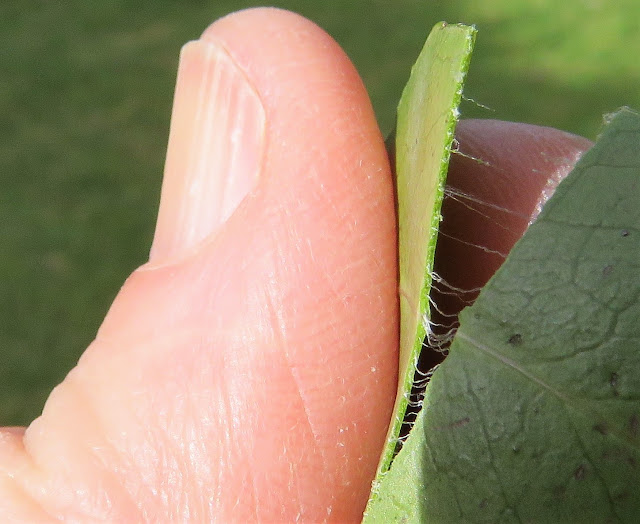Maïté demonstrating silky-leaved, homophonous Maytenus
Despite being called Silky Bark, this tree is best known for its silky leaves. Maytenus acuminata is a common plant in the Little Karoo, making it slightly odd that I find and photograph it in the Harold Porter National Botanical Garden on the coast near Cape Town, rather than in the botanic garden I featured the last two posts.
I was there in August 2018 and the tree was brought to my attention by an excited Maïté Delmas, Chargée de Relations Internationales at the Museum National d'Histoire Naturelle in Paris, who said it was 'her tree', the genus name being a homophone with her first name.
The tree is 'identified' by, gently, tearing a leaf in two. As with a few other plants (Cornus springs to mind) there are silky connecting threads revealed. The common name isn't incorrect, though, and you can find the same threads if you peel and tear the bark. And, apparently, the fruit.
All rather disruptive to the tree but it seems to handle it well. The flowers are small and obscurely coloured, followed by more obvious fruits. When in full fruit the tree gets an 'attractive orange hue', apparently.
The threads emerging from leaves and bark are different to those in Cornus which are the elastic thickenings of some cells in veins (the xylem). In the case of Maytenus the threads are from long cells (called laticifers) producing a stretchy rubber-like substance called polyisoprene, found throughout the plant including the veins (but in this case the phloem).
The genus is used for timber and dyes, and has some medicinal applications. This species is mostly grown as an ornamental, and to be torn to shreds by curious tourists.
Maytenus is in the family Celastraceae, along with the Spindle Tree, Euonymus. We have four of the 200 mostly tropical or warm temperate species of Maytenus growing in Melbourne Gardens but not Maytenus acuminata.
As to the link to connection with Maïté, that doesn't really exist. The name is from a common name used in Chile, Mayten. Given it's my hand in all the pictures, I'll finish with Maïté, next to her tree, the Maytenus.






Comments